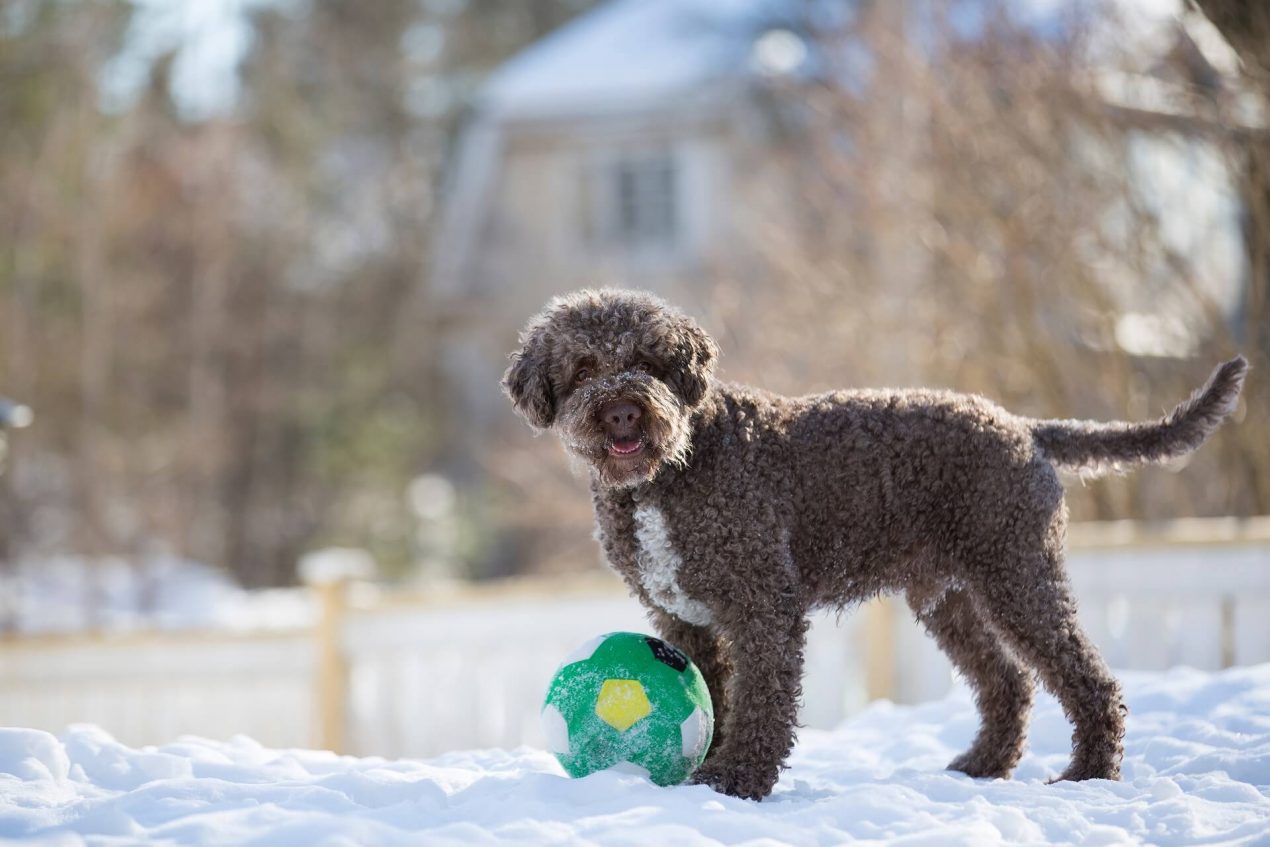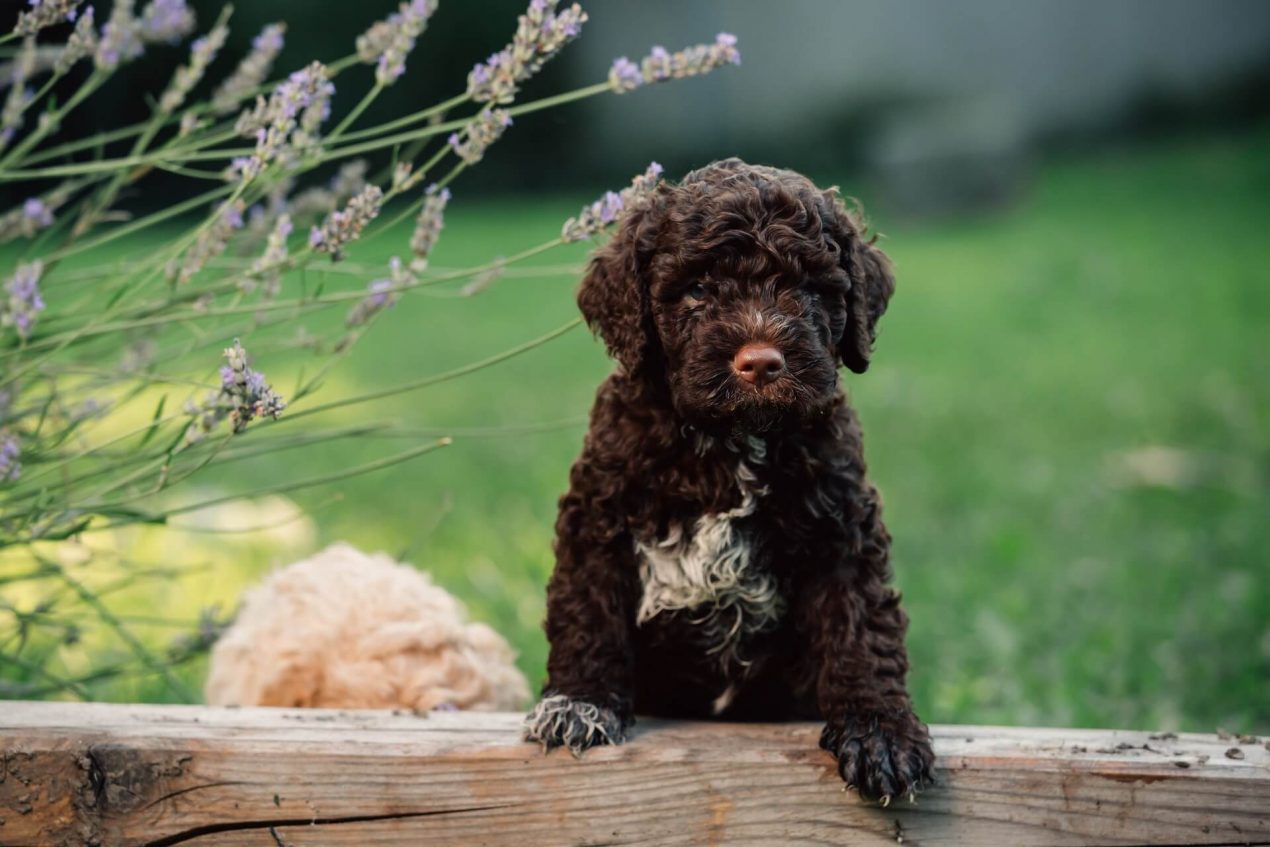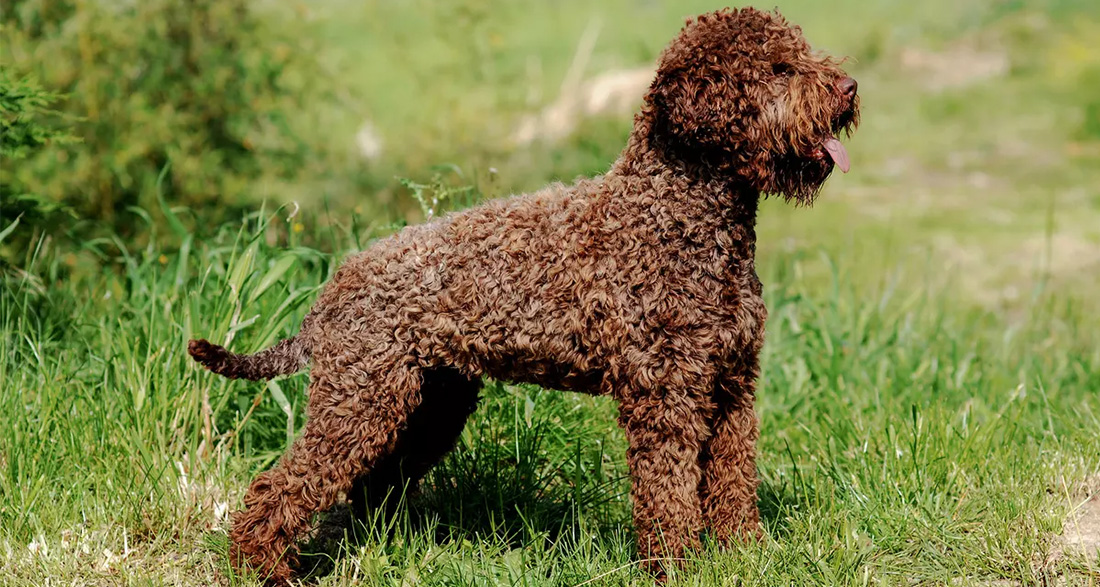The Lagotto Romagnolo has made a name for itself in Italy as the most well-known truffle dog, thanks to its excellent sense of smell. Although it is still relatively uncommon in our regions, this friendly fluffy-headed dog is becoming increasingly popular as a family pet. Let’s learn more about this sporty truffle-hunting dog.
History of the Lagotto Romagnolo
The Lagotto traces its roots back to ancestors from the 17th century, which were most likely Italian water dogs from the Romagna region. Romagna is a historical area in northern Italy, known for cities like Ravenna and Rimini. In the marshlands of Romagna, the water dog was used as a hunting dog. It reliably tracked down waterfowl and retrieved them for the “Vallaroli,” the lagoon hunters. It also assisted the local fishermen and guarded their belongings. The name “Lagotto” likely stems from the dog’s role as a water dog, as “Càn Lagòt” translates to “water dog” in the dialect of Romagna.
After the draining of the Romagna marshes at the end of the 19th century, the Lagotto Romagnolo became practically unemployed. However, due to its excellent sense of smell, it was employed in truffle hunting. Since the expensive fungi grow underground and are only detectable by scent, the Lagotto’s skills were highly valued. The Lagotto is extremely disciplined and reliable in its work, only signaling when it has found the valuable truffle; it neither digs it up nor eats it. In Italy, its abilities are still highly regarded today, and it is specifically bred for truffle hunting.
To further optimize its sense of smell, other breeds with excellent scenting abilities, such as hunting dogs like Setters, English Pointers, Bracken, Spinone Italiano, or Poodles, were crossed with the Lagotto. Subsequently, enthusiasts of the original Lagotto Romagnolo breed returned to its roots in the mid-1970s and began breeding the original Lagotto type. In 1995, the Lagotto Romagnolo was provisionally recognized as a breed by the FCI. In 2005, the FCI definitively recognized it as an Italian breed. As a “water dog of Romagna,” it belongs to FCI Group 8 “Retrievers, Flushing Dogs, Water Dogs,” Section 3 “Water Dogs,” and bears the FCI Standard number 298.
Breed Overview
GROUP: Sporting
HEIGHT: 17 to 19 inches (males); 16 to 18 inches (females)
WEIGHT: 28 to 35 pounds (males); 24 to 30 pounds (females)
COAT: Wooly, curly, water-resistant double coat
COAT COLOR: Solid off-white, white with orange or brown patches, brown, brown roan, brown or orange with white patches, or occasionally tan markings
LIFE SPAN: 14 to 17 years
TEMPERAMENT: Intelligent, athletic, friendly, loyal
HYPOALLERGENIC: Yes
ORIGIN: Italy
Appearance of the Lagotto Romagnolo
The Lagotto Romagnolo has a dense, curly, slightly oily, hard, medium-length coat. Therefore, it is often mistaken for a Poodle mix. The non-shedding coat of the truffle-hunting dog varies from solid dirty white, various shades of brown, solid orange, white with brown or orange spots. The Lagotto may have masks in brown to dark brown.
In terms of stature, it is rather robust, almost square, but well-proportioned, with relatively long legs. With a height of up to 48 cm, it is considered a small to medium-sized dog. Its large snout and round eyes come in shades of light to dark brown. The dog’s hairy tail, tapering towards the tip, reaches approximately to the ankle. The Romagna water dog sports medium-sized, triangular ears that hang down.
Nature and Character
The Lagotto Romagnolo is a very lovable, intelligent, and industrious dog, well-suited for families with children. Playful and affectionate, he eagerly participates in family activities. He forms a loyal bond with his owner and is devoted to them. Furthermore, the Lagotto Romagnolo’s character is marked by simplicity and eagerness to learn, making him an ideal dog for beginners. He belongs to the category of dogs with a strong “will to please,” meaning he is eager to please humans. If a novice dog owner makes a mistake, he forgives quickly, as he is not at all vindictive.
It’s important to remember that this four-legged companion is a working dog. This means that both physical and mental stimulation are essential. Only then is he content and balanced. Particularly in his first two years of life, this Italian furball is a bundle of energy. If properly exercised, free-roaming poses no issue. While the hunting instinct has been largely bred out, it can resurface if he is not sufficiently stimulated.
The friendly truffle dog generally gets along well with other animals. If introduced to other pets from a young age, he can live harmoniously with dogs, cats, or even rodents. He is happy to reliably guard his home, without excessive barking or aggression.
| Affection Level | High |
| Friendliness | Medium |
| Kid-Friendly | Medium |
| Pet-Friendly | Medium |
| Exercise Needs | Medium |
| Playfulness | Medium |
| Energy Level | Medium |
| Trainability | High |
| Intelligence | High |
| Tendency to Bark | Medium |
| Amount of Shedding | Low |

Acquisition of a Lagotto Romagnolo
The Italian truffle dog was previously very rare in the United States, with only a few breeders. However, the increasing demand is difficult to meet. Currently, around 200 Lagotto Romagnolo puppies are registered by the AKC each year. If you want to buy a Lagotto, you should expect to invest between $1,500 and $1,900 with reputable breeders.
What should I consider when buying?
When purchasing a Lagotto Romagnolo puppy, only buy from reputable breeders registered with a breeding association. Good breeders also conduct genetic tests on their dogs to rule out hereditary diseases such as epilepsy. Additionally, reputable breeders can provide documentation of health checks, deworming, vaccinations, and breeding papers.
A responsible Lagotto Romagnolo breeder will not separate his puppies from their family before the age of 8 weeks. They will also allow you to meet the puppies before purchase, ensuring they come from a good home. Furthermore, the breeder should ask you many questions to ensure their Lagotto puppies are going to good hands.
Under no circumstances should you buy puppies offered at a low price, as this always comes at the expense of the animals’ health. Health checks, deworming, and adherence to breed standards cost money, which these supposed breeders do not want to invest.
Development and Training of the Puppy
Lagotto puppies are very eager to learn and easy to train. As the Lagotto Romagnolo is very sensitive, he should never be trained too harshly. While consistency is necessary, it should be coupled with love and understanding. With plenty of empathy and praise for desired behavior, he is easily trainable.
Like all young pups, the truffle dog needs to learn rules and ideally have a well-structured daily routine. Sufficient rest periods are also essential. Puppies need plenty of sleep – up to 22 hours a day – to ensure proper development. If dogs don’t get enough rest, they can quickly become overexcited, irritable, or even more susceptible to illnesses.

Like all small quadrupeds, the Lagotto Romagnolo should attend puppy school to socialize well. Being very open and friendly, he will surely enjoy playing with other dogs. Additionally, from an early age, he must learn ordinary things like potty training, being alone (even if only for very short periods at first), grooming, and body care. He should be introduced to grooming tasks like clipping and ear plucking at an early age. Moreover, he needs to get used to living with his new family and possibly other pets, riding in the car, visits to the veterinarian, or being called back while off-leash.
How do I care for a Lagotto Romagnolo?
The energetic Lagotto requires a lot of time for his stimulation. He feels particularly comfortable with sporty, active humans. He especially enjoys having a large home, preferably with a garden, where he can romp around frequently. The Lagotto Romagnolo is an active dog who enjoys participating in whatever activities his human family offers.
Activities with the Lagotto Romagnolo dog
In Italy, the reliable working dog is still used as a truffle hunting dog today. His “impermeable,” slightly oily, curly coat with a waterproof undercoat reliably protects him from icy cold in the water and on land. He is undistracted by anything from his work and is more reliable than a truffle pig, which might prefer to consume some truffles itself.
If you cannot provide truffles for the scent dog to search, then you should definitely offer suitable alternatives. If his work drive is not satisfied and he is not sufficiently stimulated, he will seek out his own entertainment. And this usually does not meet the satisfaction of his owner. His innate hunting instinct may surface, or he may cause mischief at home because he is simply under-stimulated.
As the Lagotto is a working dog, he has tremendous endurance and loves any activity that stimulates him physically and mentally. In addition to extensive walks in nature, jogging, cycling, swimming, search and intelligence games, almost any type of dog sport is suitable for his stimulation. Due to his excellent sense of smell, scent-oriented dog sports are ideal. For example, Mantrailing or tracking. Thanks to his keen sense of smell and balanced temperament paired with friendliness, the Lagotto Romagnolo is also excellent for training as a search and rescue or therapy dog.
Health and Grooming
Health: The Lagotto Romagnolo is generally a very robust dog, unaffected by cold, snow, and ice. With good health and care, he can live to be between 15 and 17 years old. However, like all dogs, he is prone to breed-specific diseases. For the Lagotto, genetically inherited epilepsy and lysosomal storage disease, a hereditary nerve degeneration, are known.
Coat Care: Although the Italian Water Dog does not shed, this does not mean that his coat does not require maintenance. After walks, twigs, burrs, and dirt often get caught in his curly hair. Additionally, puddles are pure joy for this water-loving quadruped. If he cannot swim in larger bodies of water, he will make use of even the smallest puddle, or even cow or horse dung, for a “bath.”
After a walk, you’ll need to brush or even bathe him, depending on how dirty or smelly he is. Additionally, his coat must be clipped several times a year to prevent matting. If you’re not able or willing to do this yourself, you’ll need to invest a significant amount per year in a dog groomer. However, this will result in a well-groomed Lagotto Romagnolo.
Ear Care: According to the breed standard, his ear flaps should be hairy inside. However, this has the disadvantage that the hair grows into the ear canal and can clog it over time. If the ear cannot be properly ventilated, it can easily become inflamed, which is very painful. Therefore, you’ll need to regularly pluck the hair from the ear canal, about every two weeks. There are special tweezers and ear powder available to make this procedure easier.
Nail Care: For most Italian truffle dogs, their claws are so hard and strong that they do not wear down naturally through sufficient outdoor activity. Therefore, you should regularly check the claws and possibly trim them with a nail clipper.
Nutrition: You should provide the energetic Lagotto with only high-quality food – dry, wet, or fresh. Good food also contributes to good health. The food should not contain preservatives, sugar, or chemical additives. Instead, it should contain sufficient proteins, vitamins, and minerals. It’s best to avoid grains, as more and more dogs are developing allergies in this regard.
Dental Care: For dental care, you can give the Romagna Water Dog a chew bone daily, such as dried beef scalp. Additionally, you should regularly brush his teeth with a soft toothbrush and dog toothpaste. This prevents tartar formation and keeps the quadruped from needing to have decayed teeth pulled.
Interesting and Worth Knowing
Although the Lagotto Romagnolo does not shed, he is not automatically suitable for allergy sufferers. It’s not the hair that triggers allergies, but rather the dog’s saliva, dander, or urine.
Do you also have a Lagotto Romagnolo or are you planning to get one soon? Tell me more in the comments!


